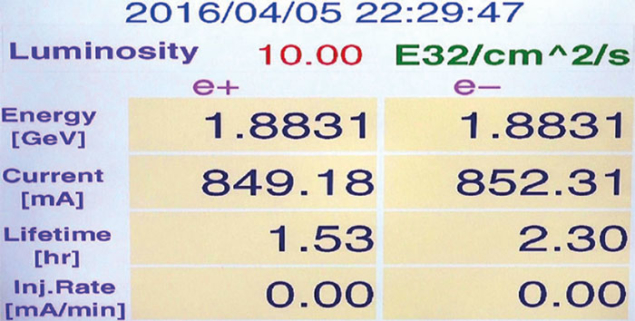
Image credit: BEPCII.
A new luminosity record at the charm-tau energy region was recently broken again by the Beijing Electron–Positron Collider (BEPCII). The new record, 1 × 1033 cm–2s–1 at 1.89 GeV beam energy, is also the design luminosity for this collider at its design beam energy.
BEPCII, the upgrade project of BEPC (CERN Courier September 2008 p7), is a double-ring collider working at 1–2.3 GeV beam energy with a design luminosity of 1 × 1033 cm–2s–1 at an optimised beam energy of 1.89 GeV. Because of its performance, BEPCII can be seen as a charm-tau factory. The same as BEPC, BEPCII is characterised as “one machine, two purposes”. Indeed, the machine not only provides beam for high-energy physics experiments, it also provides synchrotron-radiation (SR) light to users in parasitic and dedicated modes.
BEPCII is installed in the tunnel that hosted its predecessor, BEPC. Its electron and positron rings, called BER and BPR, respectively, have a circumference of 237.5 m. BER and BPR run in parallel and have a crossing angle of 22 mrad at their interaction point (IP). On the opposite point to the IP, BER and BPR cross with a vertical bump created for each beam by local correctors as its original design. The third ring, BSR, resulting from the connection of the two half rings of BER and BPR, has a circumference of 241.1 m and can be run as a dedicated synchrotron light source at 2.5 GeV energy and a maximum beam current of 250 mA.

Image credit: BEPCII.
Installation of BEPCII was completed in 2006. Since then, the machine has passed the national check and other tests, together with its new detector, BESIII. In mid-July 2009, the luminosity reached 3.2 × 1032 cm–2s–1. The data-taking for high-energy physics started in August 2009. Besides running at 1.89 GeV design energy from 2010 to 2011, BEPCII has been run at other beam energies, from 1 GeV to 2.3 GeV, for different high-energy physics experiments.
Enhancing measures
In the past seven years, some measures have been taken to enhance the peak and integrated luminosity:
• A longitudinal feedback system was installed to suppress the longitudinal multibunch instability in 2010. During the high-energy-physics data-taking, the horizontal betatron tunes of two rings were moved to very close to half integers – 0.504 or 0.505. The luminosity at the design energy reached 5.21 × 1032 cm–2s–1 in 2010, and 6.49 × 1032 cm–2s–1 in 2011 with 720 mA/88 bunches/beam.
• In 2011, the vacuum chambers and eight magnets near the north crossing point were moved by 15 cm to mitigate the parasitic beam–beam interaction. The movement changed the layout of the machine and the beam separation from vertical to horizontal.
• The betatron tunes were changed from the region of (6.5, 5.5) to (7.5, 5.5), reducing the momentum compaction and shortening the bunch length. A luminosity of 7.08 × 1032 cm–2s–1 with 735 mA/130 bunches/beam was achieved in 2013.
• The emittance was increased from 100 nm· rad to 128 nm· rad to increase the single-bunch current. The luminosity reached 8.53 × 1032 cm–2s–1 with 700 mA/92 bunches/beam in late 2014.
High beam current is the main feature of this type of collider, which is also a big challenge for BEPCII. The direct feedback of the radiofrequency system was turned on, which helps higher beam current to be more stable. The transverse-feedback system was another big challenge. Beam collision helps to suppress the multibunch instability in the positron ring. The bunch pattern was optimised carefully to increase the luminosity. Finally, thanks to the efforts of all of the accelerator team of BEPCII, the design luminosity, 1 × 1033 cm–2s–1 with 850 mA/120 bunches/beam at its design energy, which is 100 times higher than the luminosity of BEPC at the same beam energy, was reached at 22.29 p.m. on 5 April 2016. The breakthrough from BEPC to BEPCII is now completed.





